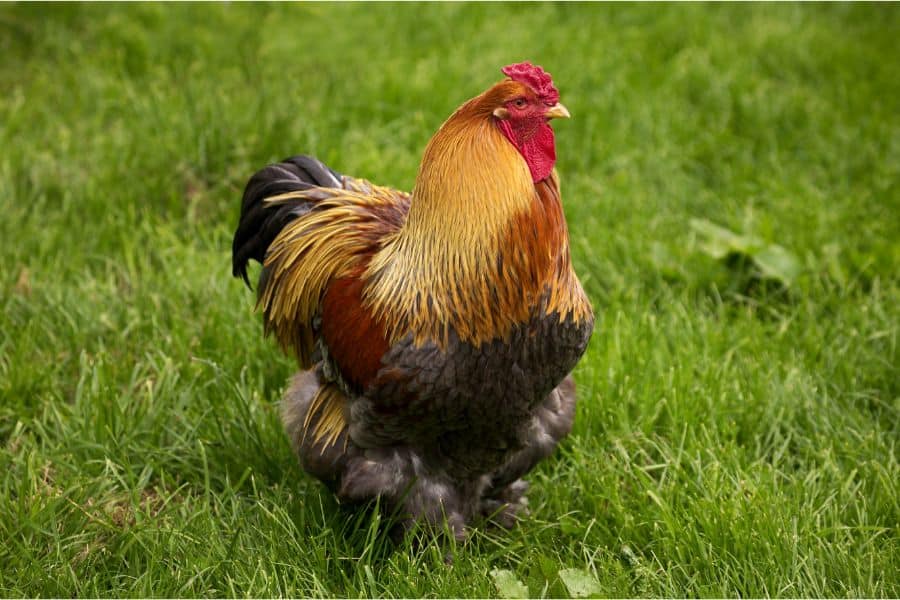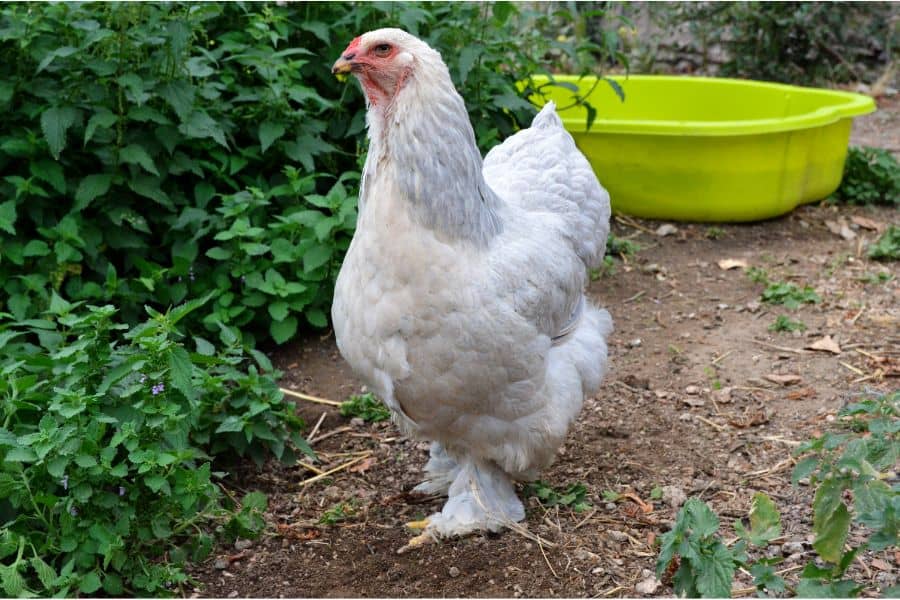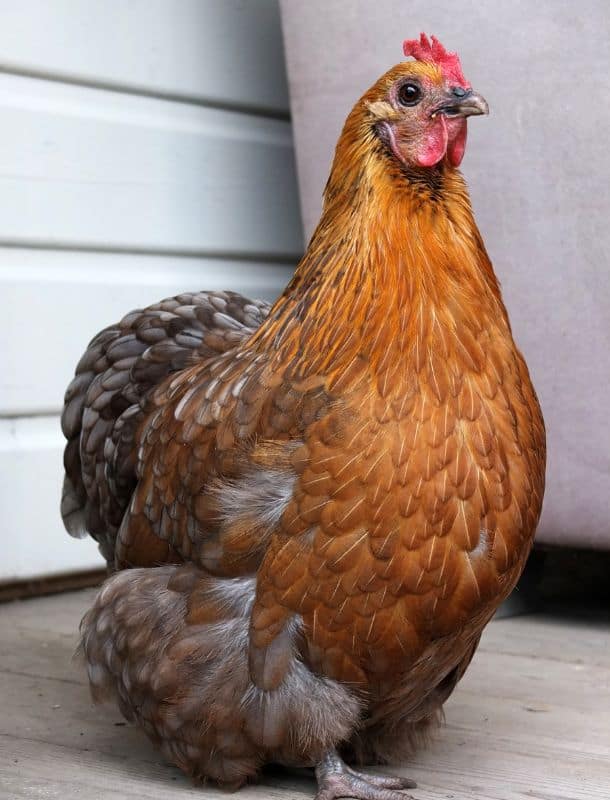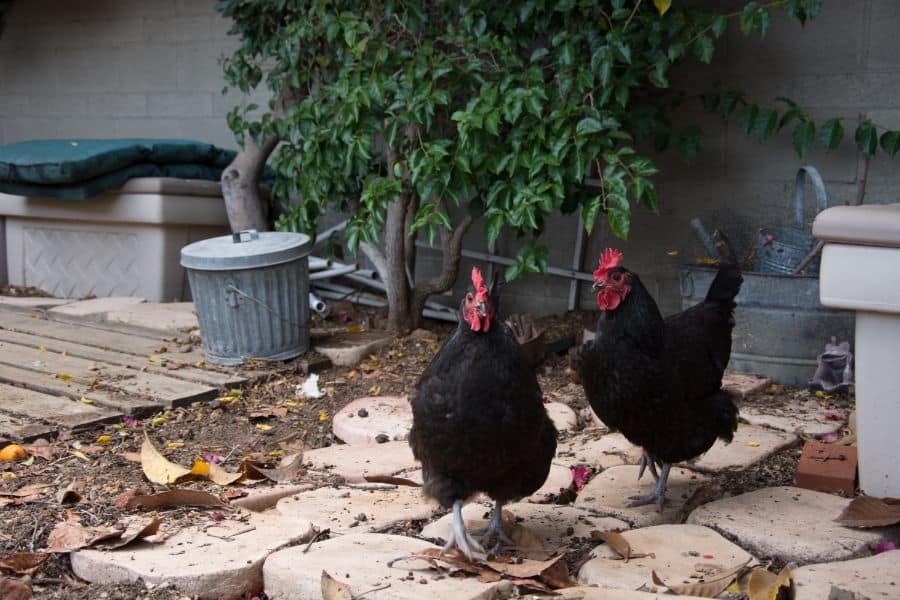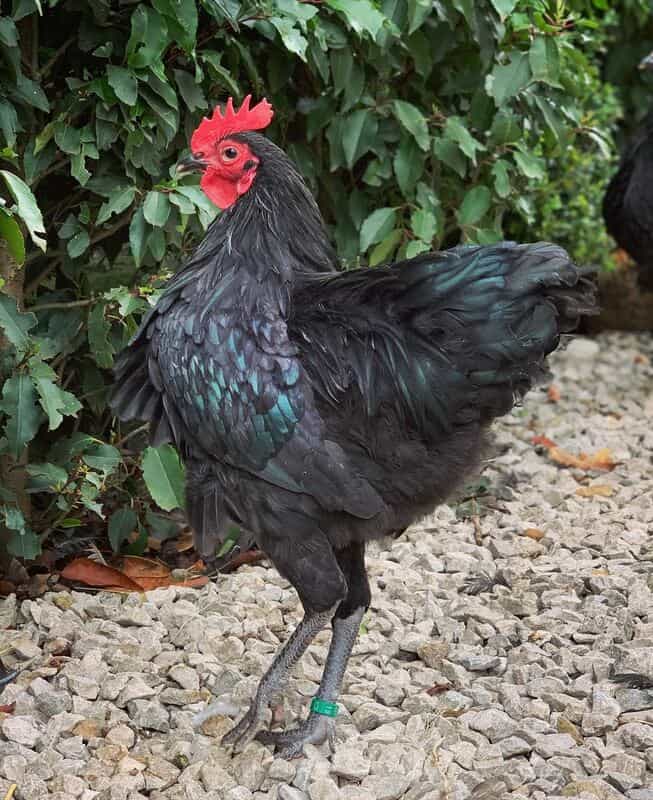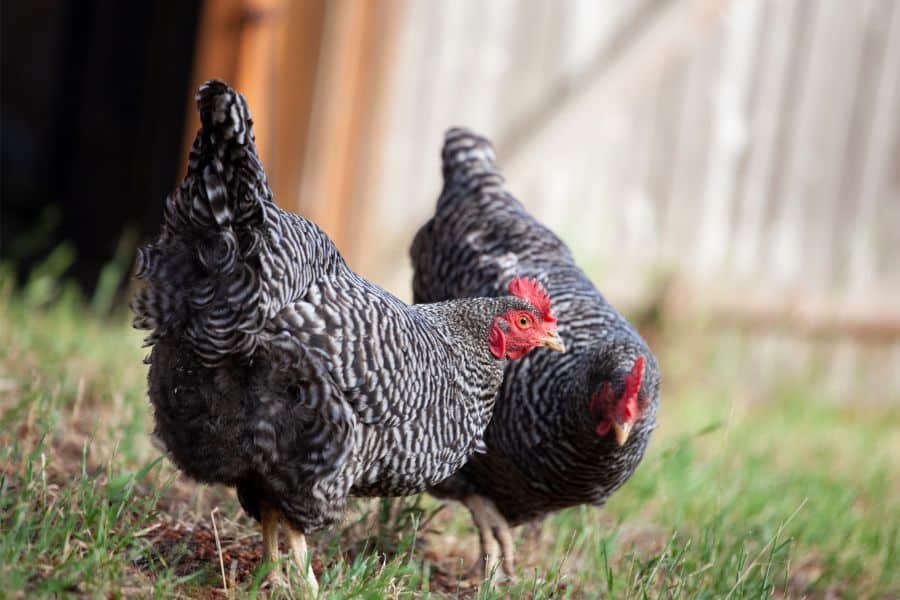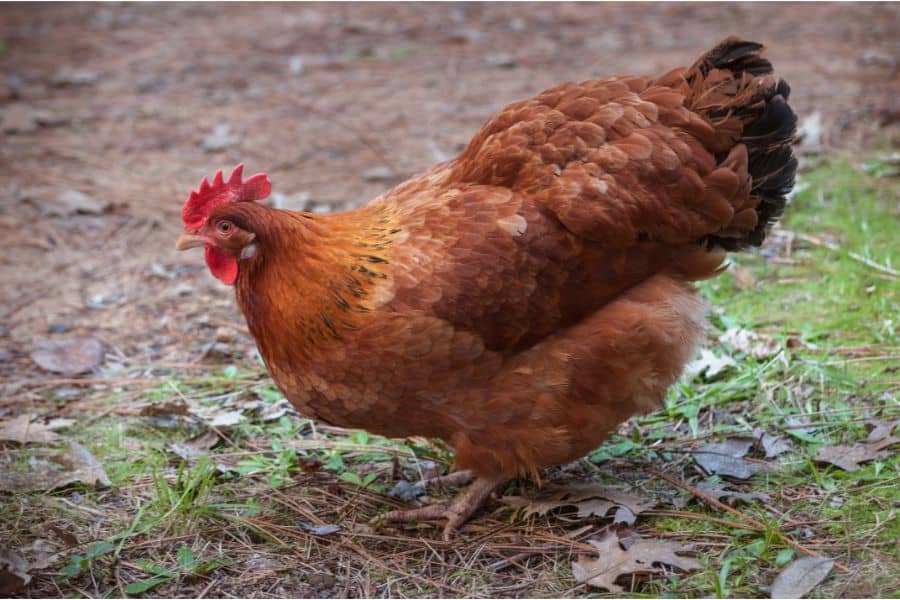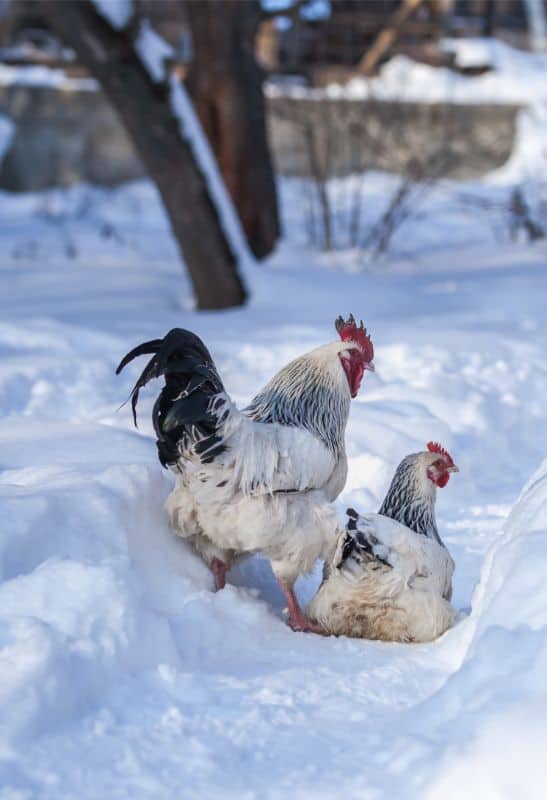Are you a chicken parent aspiring to take your passion for the feathered friends to a new level. Or, could you be just a curious mind looking to learn some of the fascinating wonders of the avian world?
Either way, with some of the largest chicken breeds, you can redefine chicken parenting and discover more about our feathered friends.
In this blog post, I’ll take a deep dive into some of the world’s largest chicken breeds. From the majestic jersey giant to the mighty Brahma, our cherry-picked feathered marvels will leave you awe-inspired with their massive sizes. Let’s dive right in!
The 12 Largest Chicken Breeds
Do you know that the smallest chicken breed, Malaysian Serama bantam, weighs as low as 1 pound when mature? In case you’ve got no idea on just how much that amount of weight is, think of a pack of dried spaghetti.
But then, poultry world is one area where nature has fascinating diversity regarding size – and you’re just about to discover that. Let’s explore some of the world’s giant chicken breeds that redefine the meaning of “big”.
1. Jersey Giant
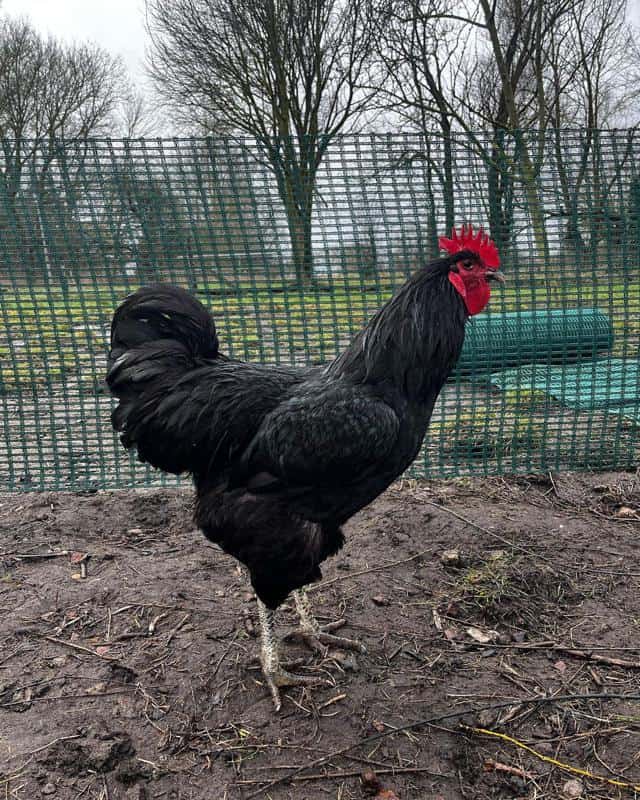
- Weight – 13 pounds
- Height – 26 inches
- Eggs per year – 150 to 200
- Egg size – Large
Starting off our curated list is the Jersey Giant. It’s the world’s largest chicken breed. The colossal chicken breed weighs about 11 pounds if it’s a hen and about 13 pounds or even more for the roosters. The height can reach 26 inches.
Jersey Giant was developed in the 1870s by the Black Brothers with their main aim being to come up with a giant bird to replace the turkey as a meat bird. As such, they worked with crosses of Orpingtons, Langshans, and Javas.
The original color of this breed was black, but two more color varieties – white and blue – were later introduced. The blue variant is the most recent of the three and was registered in 2003 by the American Poultry Association (APA).
With this docile chicken breed, you can expect to get 150 to 200 eggs per year depending on the weather, level of comfort, and other factors. That’s still impressive, especially considering that the egg size is larger than that of an average chicken.
But for a meat bird, Jersey Giants don’t fit the bill, and that’s because they take too long to develop. In fact, these birds have to first develop a large frame until they’re 6 months before filling it with meat – which is quite a long time considering the food demand that comes with their size.
2. Malay Chicken Breed
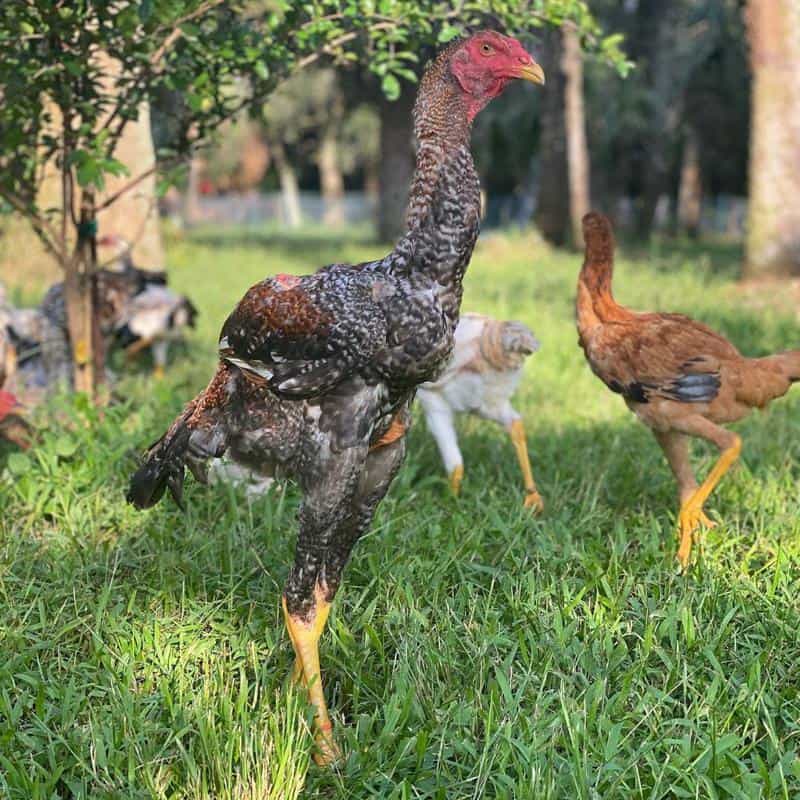
- Weight – 9 to 11 pounds
- Height – 36 inches
- Egg per year – 90 to 120
- Egg size – Medium to large
While they come second on our list, Malay chickens aren’t the second-largest chicken breeds in the world. However, the fact remains they’re still among the giant feathered buddies in the avian world.
These birds have a towering height of 36 inches, making them the world’s tallest chicken breeds. But don’t let that height fool you – they only weigh about 9 to 11 pounds, which is less than that of Jersey giants.
Originally, the Malaysian breed was used for cockfighting. But currently, they’re primarily bred for showing and ornamental purposes, although they also make fantastic breed for meat and egg production.
Kept as layers, Malay chickens will lay between 90 to 120 eggs per year. But they only produce eggs during the egg-laying season, so ensure that you have that at the back of your mind before you get one.
It’s also worth noting that Malay chickens are aggressive, especially towards other smaller chicken breeds. That’s to say, if you have a mixed-breed flock, you may need to work with other friendlier breeds to ensure peace.
3. Dong Tao
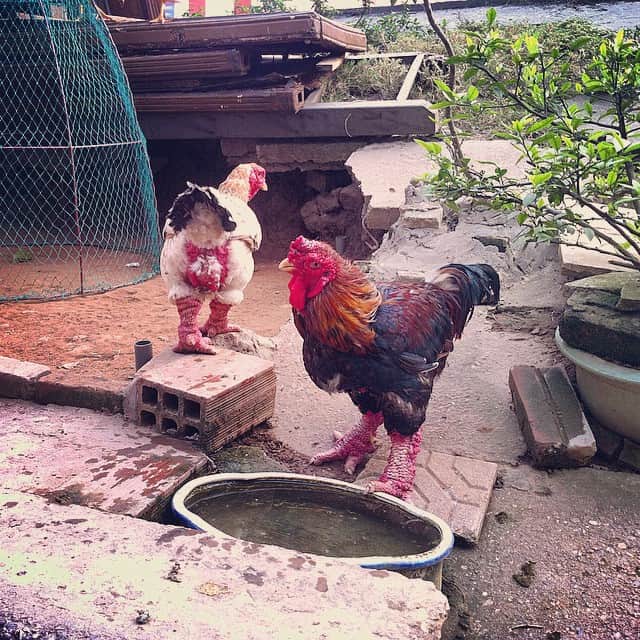
- Weight: 13 pounds
- Height: 16 inches
- Eggs per year: 60
- Egg size: Large
This Vietnamese chicken breed is sometimes referred to as the dragon chicken, and that’s because the variety comes with an enormous scaly feet that will sometimes grow as thick as a person’s forearm.
A healthy Dong Tao chicken can weigh about 13 pounds, which means they lie somewhere in between the Jersey giant and the Malay chicken breeds. As for the height, it may vary a bit, but they usually stand 16 inches when fully grown.
The giant chicken breed is famous for its high-quality meat and was, at some point, bred to provide meat for the Vietnamese royal family. So, if you’re looking for a giant chicken breed that can serve well for meat production, Dong Tao is one variety you should bring on board.
But it’s a rare breed and expensive too, with one chicken going for as high as $2,000. This price tag puts it second on the list of most expensive chickens only after Ayam Cemani.
With this chicken variety, expect about 60 eggs per year, a much lower number than you’ll get with most chicken breeds. Even worse, they’ll often stand on their eggs and break them, which is never a desirable trait for egg-laying breeds.
4. Brahma
- Weight – 12 pounds
- Height – 30 inches
- Eggs per year – 120 to 300
- Egg size – Large
If there’s a bird breed that competes closely with the Jersey Giant, it has to be the Brahma chickens. This variety of birds can weigh up to 12 pounds, but we have rare instances where some weigh just as much as Jersey Giants or even more.
The variety is bred either for beauty or egg production. Those intended for aesthetics will deliver about 150 eggs per year – which isn’t a bad yield, especially as a secondary purpose. But for lines bred for egg production, they can reach 300 eggs per year at their best!
This bird breed comes in three standard colors – white, buff, and dark. The white and buff variants usually have a black collar and tail, whereas the dark variety typically has a white collar and black tail.
Character-wise, Brahmas are just as calm as their closely-sized larger counterparts. Plus, they serve as good breeds for meat, which means they’ll make friends with your current flock but with so much value to bring on board.
But then, these gentle giants have thick feathers all over their bodies, including feet, so only get them if you live in cold areas as hotter climates may be too hard on them.
5. Cochin
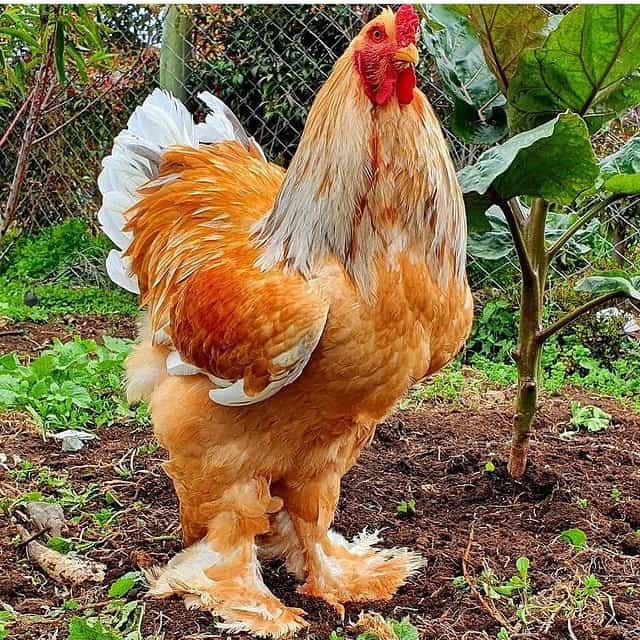
- Weight: 11 pounds
- Height – 26 inches
- Eggs per year – 150 to 200
- Egg size – Medium to large
If you’re looking for a giant bird breed that can fit in your backyard flock and at the same time make great friends with your kids, one breed to consider is Cochin. This chicken breed is just as friendly and cuddly as it is fluffy and makes a great pet.
The heavy mass of feathers on their bodies makes them appear larger than they actually are, but they’re, in the real sense, still among the giant breeds you’ll find out there. These birds will grow to about 26 inches tall and weigh up to 11 pounds, so they’re way larger than the typical chicken.
Egg-wise, cochins will usually supply 150 to 200 eggs per year when not brooding. And yes, they have all the traits of excellent mothers and will sit on any type of egg, including duck and turkey eggs, and hatch them out!
But as lazy birds with easy-going demeanor, these cuddly feathered friends can be an easy target for predators. But don’t worry – foraging isn’t their thing, and they even tend to be happier when kept in confinement.
6. Orpington
- Weight – 10 pounds
- Height – 16 inches
- Eggs per year – 150 to 200
- Egg size – Large
Orpington is a British chicken breed developed from a cross between three bird varieties – Plymouth rocks, Langshans, and Minorcas. The idea behind combining the three breeds was to come up with a giant bird that would serve as a dual-purpose bird.
This breed isn’t the heaviest on the list, but at 10 pounds of weight, it’s still one of the most massive breeds you’ll find in the avian world. The birds typically stand 16 inches tall and have heavy and densely-feathered bodies which are reasonably low to the ground.
This bird breed often come in buff, but you can still get blue, white, and black varieties. Their fluffiness means they’re better suited for a colder climate and that they’re less vulnerable to frostbites than other species.
Their giant heavy bodies may make them look intimidating, but that’s not true. In fact, Orpingtons are amiable creatures that are less likely to fight with other chicken breeds – even the smaller ones.
About egg production, Orpingtons will give you 3 to 4 eggs per week. That’s about 150 to 200 eggs annually, assuming they don’t go broody. Of course, the eggs are slightly larger than the averaage ones that you buy from the store and have a light brown shell.
7. Cornish
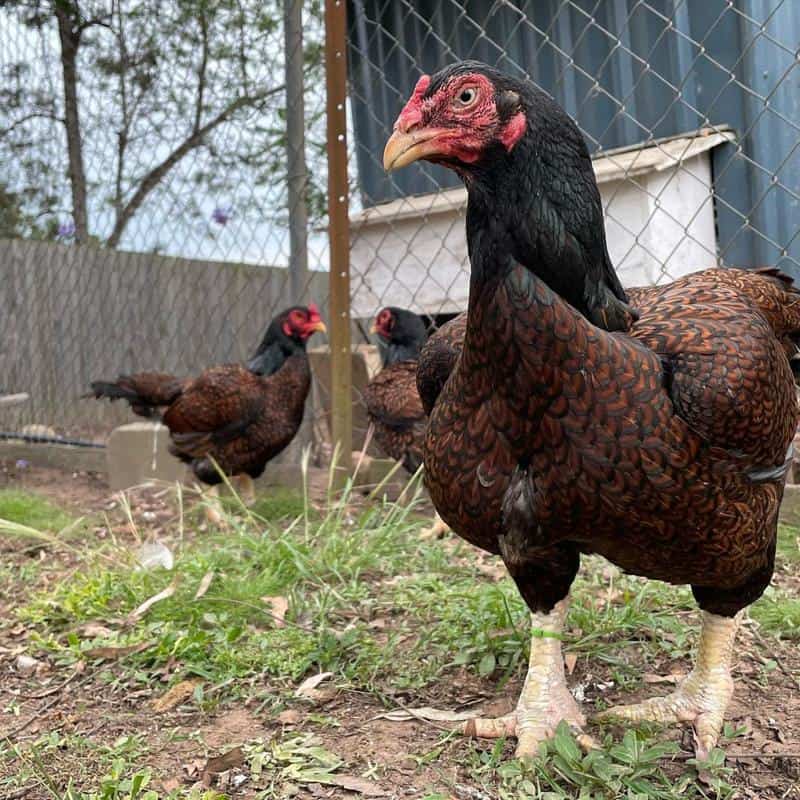
- Weight – 10.5 pounds
- Height – Unavailable
- Eggs per year – 80
- Egg size – Medium to large
The Cornish chicken breed is another giant British variety. It’s commonly known as the “Indian Game Chicken” outside the US.
It isn’t one of the tallest chicken breeds on our list, but it’s stocky enough to deserve a spot on our list of heavyweights. Cornish chickens can weigh up to 10.5 pounds and takes about 7 months to attain their maximum size.
This chicken breed can deliver about 80 eggs per year. Of course, 80 isn’t the highest number of eggs you can get from a giant chicken breed, but it’s still a good yield, especially for a variety primarily bred to serve as a table bird.
Unlike the majority of British birds, Cornish chicken breeds are short-feathered. That’s to say, their egg-laying frequency is highly affected in colder seasons.
8. Australorp
- Weight – 10 pounds
- Height – 27 inches
- Eggs per year – 250+
- Egg size -Medium to large
Australorp chickens are among the most famous giant chicken breeds, and for some good reasons – they are not only docile creatures but also good layers, with their yearly egg production likely to surpass the 250 mark.
Unlike most chicken breeds, Australorp hens don’t go broody more often. That makes them more reliable at their egg-laying role and will do it all year round – including in winter and fall!
In terms of size, this Australia’s national chicken breed weighs about 10 pounds when fully grown and can attain a height of up to 27 inches – which means they’re taller than some giant breeds in our coverage.
However, even with their great height and massive bodies, these birds aren’t arrogant. In fact, they’re very gentle, which means they’re not only less likely to fight with other members of your flock but also a great addition to families with youngsters.
9. German Langshan
- Weight – 10 pounds
- Height – 32 inches
- Eggs per year – 150 to 200
- Egg size – Medium to large
Our next giant chicken breed is native to Germany and is a product of combining Minorca, Plymouth Rock, and Croad Langshan. Thanks to its long legs, the German Langshan is the tallest of all Langshan chickens and usually comes in four colors – white, black, blue, or black-brown.
German Langshans are usually bred for shows and exhibitions. But they’re also dual-purpose birds, meaning they are good for the table and perfect egg layers that can deliver between 150 and 200 eggs per year.
Of course, they also make a calm and friendly chicken breed that can easily get into your flock without disturbing the peace. But you may need to put extra effort into searching for one as they’re a rare variety despite all the fame.
10. Plymouth Rock
- Weight – 9.5 pounds
- Height – 30+ inches
- Eggs per year – 200 to 280
- Egg size – Large
Plymouth Rock is one of the oldest American birds, with its invention dating back to the mid-19th century. There are several versions of this breed, but barred Plymouth was the first strain to be developed and was well-received, becoming the most extensively bred and kept chicken breed until the onset of World War II.
The bird weighs about 9.5 pounds and is available in multiple colors, including barred, white, buff, blue, Columbian, partridge, and silver penciled. It possesses all the desirable traits of a good farm chicken, as it’s docile, friendly, cold-hardy, and a good dual-purpose breed.
Plymouth Rock chicken breed begins to lay when they are four to 6 months, and you can anticipate between 200 and 300 eggs per year. But the egg productivity will begin to reduce when they’re 3 years, although they remain egg-productive until they’re 10.
11. Rhode Island Red
- Weight – 9 pounds
- Height – 22 inches
- Eggs per year – 260
- Egg size – Large
Rhode Island Red was developed in the late 19th century and is another American breed. The chicken breed is a favorite choice among chicken keepers due to its dual-purpose nature and good looks.
The breed will grow to about 9 pounds and is as good in an egg-laying role as a dinner table bird. As an egg producer, this bird variety will give you about 5 eggs each week, translating to a decent 260 eggs annually!
This egg count means that the breed will keep laying eggs even during the winter, making it one of the most reliable layers. But their egg yield may temporarily decrease during this time, but that won’t happen quickly like with other less weather-hardy chicken breeds.
Finally, this breed is good at evading predators, so you may need to consider getting it if you live in areas with large populations of chicken predators. But beware, the roosters can be a bit aggressive, so you may need to stick to hens if you have kids around.
12. Sussex
- Weight – 9 pounds
- Height – Unavailable
- Eggs per year – 200 to 250
- Egg size – Large
As the name suggests, this chicken breed is from Sussex in South-East England. It is available in three APA-recognized colors – white, red, and speckled, although England recognizes deep red (think of brown) plumage color on top of the three.
The Sussex chicken breed isn’t the heaviest bird, and the best it can produce on the weighing scale is 9 pounds. Nonetheless, it’s still a large and popular variety that plays the roles of an egg producer and dinner table bird exceptionally well.
This bird variety grows more rapidly than the majority of the members on our list, which is a good trait for birds kept for meat. But if you want to use it for egg purposes, you can still expect to reap an astounding 200 to 250 eggs yearly, with the egg-laying beginning at 16 to 20 weeks.
Sussex chickens are well-suited for colder climates and will appreciate temperatures of 75 degrees Fahrenheit (24 degrees Celsius) or below. They’re also great backyard pets and are easy to handle, making them a good option for those just starting poultry farming.
A Comparison Table For 12 Biggest Chicken Breeds
To make it even easier for you to know how the different giant chicken breeds compare, we’ve summarized everything in the table below.
| Chicken Breed | Max. Weight | Max. Height | Recognized Color Varieties | Eggs per year |
| Jersey giant | 13 lbs | 26 inches | Black, white, and blue | 150 to 200 |
| Malay | 11 pounds | 36 inches | Black-breasted red, spangled, white, black, red pyle, wheaten, and ginger | 90 to 120 |
| Dong Tao | 12 pounds | 16 inches | All-white, white mixed with brown, or multicolored in auburn and red, gray, white, and black. | 60 |
| Brahmas | 12 pounds | 30 inches | White, dark, buff | 150 to 300 |
| Cochins | 11 pounds | 26 inches | Buff, Partridge, White, Black, Silver Laced, Golden Laced, Blue, Brown, and Barred. | |
| Orpington | 10 pounds | 16 inches | Buff, blue, white, and black | 150 to 200 |
| Cornish | 10.5 pounds | Unavailable | Dark, white, buff, and white-laced red | 80 |
| Australorp | 10 pounds | 27 inches | Black, blue, and white | 300+ |
| German Langshan | 10 pounds | 32 inches | Black, blue, white, and brown-black | 150 to 200 |
| Plymouth Rock | 9.5 pounds | 30+ inches | Barred, white, buff, blue, Columbian, partridge, and silver penciled | 200 to 280 |
| Rhode Island Reds | 9 pounds | 22 | Darker red/brown to light rust | 260 |
| Sussex | 9 pounds | Unavailable | Speckled, red, light, and dark red (brown) | 200 to 250 |
Also Read:
Conclusion
Although giant chicken breeds may have an intimidating size, most of them are generally docile and get along well with other chickens. However, before you opt for one, remember that they are suited differently, with some being good layers, others good meat breeds, and some dual-purpose birds.
Also, ensure that you have adequate space for whatever breed you choose. Since they’re generally large, you will need to opt for a larger chicken coop to keep them comfortable and happy.
